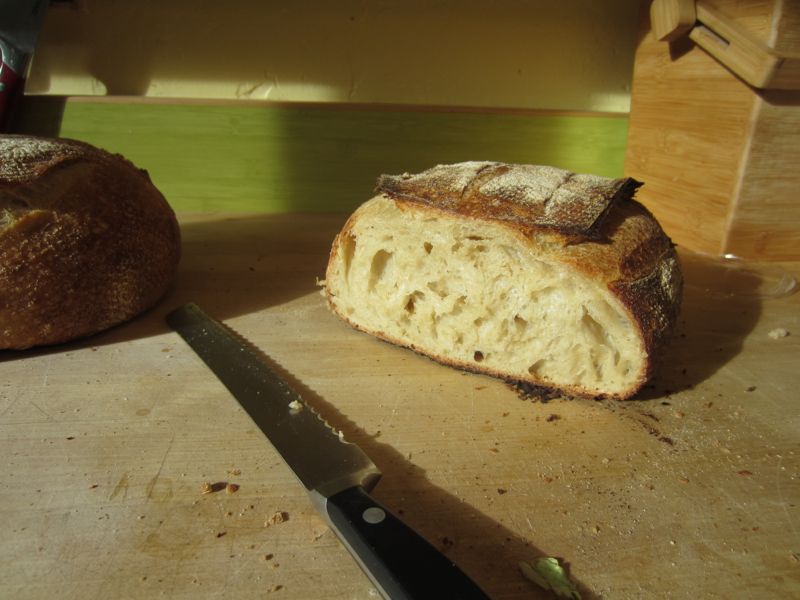Capturing and caring for Yeast
Hello, wild yeast people!
It appears that I have not recently documented how exactly it is that you “capture,” and (more importantly) feed and care for a wild yeast culture.
I should start by saying that most of what I know comes from
- “Cooked,” by Michael Pollan,
- “Tartine Bread,” by Chad Robertson,
- … and certain brief conversations with biologists at Cal Poly
The fundamental assumption behind the effectiveness of what I’m going to tell you comes from the ‘everything is everywhere: but the environment selects’ hypothesis, “promulgated by Dutch microbiologist Martinus Wilhelm Beijerinck early in the twentieth century.”1 The basic idea is that most microorganisms are present in varying densities nearly everywhere on earth, and that it’s possible, by providing the right environment, to breed pretty much any microorganism that you want.
In this case, we want a yeast culture. Some people take great care to preserve a particular culture that has been handed down for generations. My reading suggests that this is … well, kind of pointless. You can create your own culture in a week or two (or maybe less) without much fuss, and without anything but flour and water.
With that said, it’s certainly easier to preserve a culture than it is to create one, so once you’ve got it going well, it makes sense to me to keep it going. Honestly, it’s a lot like a fire was to primitive culture: starting it is a pain, and feeding it isn’t too expensive.
Okay, here’s my “recipe.” I’ve started from scratch on this twice, and I’ll probably do it again.
Ingredients
First: Okay, I said that all you need is flour and water, and strictly speaking, that’s not true: the important ingredient you’re most likely to be missing is this: a digital kitchen scale. Actually, it doesn’t have to be digital, but there aren’t a whole lot of gram-accurate non-digital scales floating around.
Second: Water. You need water. It turns out that it is possible to have problems with your water; in Maine, I discovered that our well water was acidic and had high copper. I don’t know which of these was the problem (or indeed whether the problem was something else entirely), but my yeast grew very badly there until I started using filtered water. I haven’t had any problem with the water in San Luis Obispo. I generally let it sit for a day before using it, to let the chlorine dissipate (though we may be switching to chloramines soon…). I don’t know whether this actually makes any difference.
Third: Flour. For feeding my yeast, I use 50/50 blend of Whole Wheat and White flour. Both are unbleached. Is 50/50 the right blend? I have no idea.
Fourth: a glass jar. Or a glass glass. Or a plastic glass. It should probably hold 250–350 ml.
Recipe
Step One
Note: Nothing here is written in stone, or even tested in any reasonably scientific way. It’s just what appears to work for me.
Mix 40 grams of water and 40 grams of the flour mixture, put in the glass and wait for 24 hours.
Step Two
Mix 20 grams of your mixture with 40 grams of water and 40 grams of the flour mixture. Put in the glass, and wait for 24 hours.
Step Three
There is no step three. Just keep doing Step two, every day, forever.
Why are we doing this again?
A yeast culture is good for making bread. There are many ways to use a wild leaven (what we just made) for making bread. I strongly recommend the recipe in Chad Robertson’s book, “Tartine Bread.”
Here’s what mine looks like:

delicious bread
What to Expect
Really, this started as a fun biology experiment, and I hope you’ll try it in that light, too.
One thing to be aware of; in the first week, the mixture is still settling down, and you’re going to get some very funky smells. Like really terrible old socks. A lot of people throw it out at this point. Stick with it, and after a few more days, it should setle down into a nice sour culture that grows to about twice its original volume each day, before settling back down at about 20 hours.
-
‘Everything is everywhere: but the environment selects’: ubiquitous distribution and ecological determinism in microbial biogeography, by Maureen A. O’Malley. DOI: http://dx.doi.org/10.1016/j.shpsc.2008.06.005 ↩